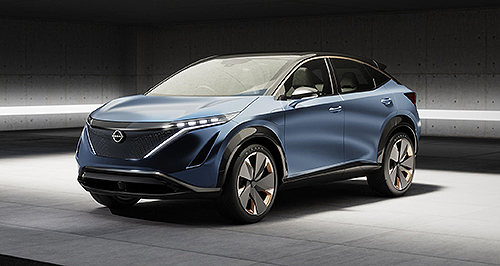News - NissanNissan’s new era of design explainedGet a taste: The all-electric Ariya Concept previews a zero-emissions SUV due to be revealed next year as the first example of Nissan’s new design language. For the 2020s, Nissan design strives for ‘powerful minimalism’ but in a Japanese way6 Nov 2019 By BYRON MATHIOUDAKIS in TOKYO NISSAN has revealed its design philosophy moving forward, which is striving for ‘powerful minimalism’ in order to revitalise a brand that even its chief designer admits has fallen well behind in recent times.
Speaking to the press at the company’s design and engineering headquarters in Tokyo last month, Nissan’s senior vice-president of global design, Alfonso Albaisa, said there are over 60 projects on the go within his department right now, signalling a renewed and reinvigorated level of activity happening at the moment.
“We have more than 500 people, designers and modellers … with about 15,000 engineers, too,” he said. “Design director Giovanni Arroba and I have been in our current position here for three years, and we came with a midterm plan … and the portfolio that is very old is about to become one of the youngest portfolios in the world.”
Mr Albaisa said that when he started back in 2016 as Nissan’s first non-Japanese design boss, he contacted the heads of all eight global studios – in India, China, Brazil, USA, Thailand, China and two in Japan – to define in one word what is meaningful to them about Japanese design and Japanese culture.
These included the words ‘Ma’ – the mastery of the empty space; ‘Kabuku’ – the embracing of something unusual and something strange; ‘Iki’ – to bring the cutting edge or concise newness to the everyday; and ‘Utsuroi’ – the sensitivity derived from this very Japanese reverence for nature.
Mr Arroba describes Nissan’s new design direction – especially as pertaining to EVs – as needing to contain the two opposing notions of moving forward while looking back simultaneously, all while adhering to those one-word definitions of design and culture.
“We wanted powerful minimalism – timeless Japanese futurism, where we want to push forward and advancing, yet with timeless we carry our heritage behind us, a 100-year history of being a car-maker, the history of the automobile,” he said.
“So, somehow, we move forward with that echo and create something that is very futuristic yet easy to relate to as a customer.”
Mr Albaisa said that Nissan’s wholesale adoption of electrification actually works harmoniously with his department’s design philosophy since the very processes of eliminating the internal-combustion engine components lines up with taking away excessiveness and clutter.
“Electrification is a massive reduction of mechanical complexity, from an engineering side … and when you are designing an EV platform from scratch, you are also simplifying the platform,” he explained.
“But in design, we don’t need to follow that – we can make shape with anything. Yet, it was also an inspiration for us, about cleaning and making more seamless design, because we felt there is a modern side of technological revolution that is about minimalization.”
However, Mr Albaisa added that given Nissan is a Japanese company, the European notion of minimalism is a bit foreign to him and his team since European minimalism such as Bauhaus is subtractive (about removing things to get to purity), while the former’s is not necessarily about reduction but instead about mastering the physicality of the space.
“So, we have this great opportunity now and we are reshaping the brand,” he said. “How do we capture a little bit of this future modernism and a little bit of this Japanese quirkiness with super-sharp tech? Nobody has done this quite like this before.”
Mr Albaisa finished up by revealed that he constantly refers to those Japanese words in order to stay on track while keeping an eye on the other brands within the Nissan portfolio, Infiniti and Datsun.
“I need to be completely focused, there are 26 programs in the studios right now, and in order for me to capture this Japanese futurism that Giovanni is talking about and I believe 100 per cent in, I need to find those meanings … and mixing them with minimalism, I think we end up with something really special, where the object itself is quite simple and harmonious, but there are some elements that are literally unusual.
“And this is the defining element of the whole thing, where we are right now … and we are in love with these things … and still we are finding beauty in these things because they can make things different and special for people.”  Read more |
Click to shareMotor industry news |
















Facebook Twitter Instagram